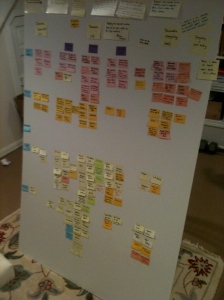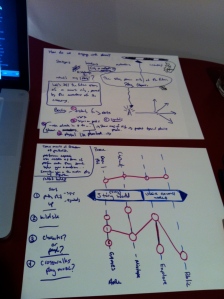Because I love bookshelves, that’s why.
Not the Ikea, $29 tubes and mesh type, but real, wood bookshelves. My bookshelves support and display tangible artifacts of the world’s second oldest profession–storytelling–in the form of books and artwork. I love picking them up, thumbing through to favorite bits of narrative and sharing them with other people. I loan books out often without remembering who I loaned them too.
A good story requires and offers interaction. Interaction with people (face-to-face), technology, or a space, or any combination of the three. A good story takes us through the four orders of design in a whirlwind and revealing way. The shift to a participatory culture certainly increases both the opportunities to interact and the value that we can take from these interactions, but somehow, story just seems to be getting lost. Book stores are closing. Movies rely on a bevy of special effects to tell a “story.” Books on eReaders allow for no evidence of interaction or meaning. But yet story still holds so much power, and as we rely more and more on technology, I believe we’re going to have to reinvent how stories are told. Vague, I know. Am I talking about reinventing Hollywood? No. But I believe there are ways in which we could use native technology to tell compelling stories that have audiences larger than our pool of family and friends. And that, my friends is where I’m starting.
So I’m looking out the windows and checking for obstacles right now. Checking out the landscape, looking behind me, checking my rear and side mirrors, and putting this thesis in gear.
Transmedia as a word pisses a lot of people off, and as a writer who cares about craft, I can sure understand why. Forget the word for a second and focus on the concept that the word should impart–it’s the process of telling a story using a variety of media formats, and letting the strength of the medium dictate the component of the story that is told through that channel. Basing the future of storytelling on the fads of today is a recipe for disaster. It takes a good storyteller, with a great story to tell, to engage people deeply enough such that fumbling from one site to a social media outlet is desired. No, the future of storytelling rests with the storyteller, and not the technologists. The technology we will be using in 5 or 10 years isn’t the technology of today, so why design something for the future based on technology today that is already on the decline?
So I’m moving forward as a novice. A novice designer, an experienced storyteller, and a virgin transmedia designer.
If the world I wish to inhabit for the rest of my life is one in which I tell stories in a new digital manner, and one in which I can consult others to tell their stories using current and emergent technology, then it stands to reason I should immerse myself in that world now, as a beginner, looking for mentors and leaders.
And if all this works, maybe I’ll be designing the bookshelves of the future as well.




